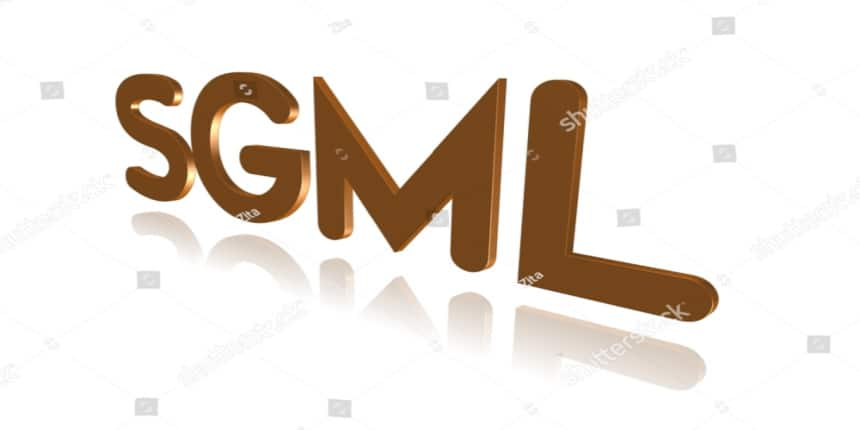SGML Full Form
What Is The Full Form Of SGML?
SGML stands for "Standard Generalized Markup Language", also called ISO 8878. It is a metalanguage, an international standard used for defining or standardizing generalized markup languages. Markup languages use notations called 'tags' to specify the function of a text. SGML is a standard used for structured documentation which means it can be used for checking if each element of the document is used in the correct place. SGML can also be used for single-medium conventional publishing to multimedia database publishing. It is also used for sharing machine-readable documents in government law and industry and is also applied in the military, aerospace, and technical publishing industries.
- What Is The Full Form Of SGML?
- History of SGML
- What Is Generalized Markup Language?
- What Are The Two Main Postulates of Generalized Markup Language?
- What Are The Parts of SGML Syntax?
- SGML Parts
- Doctype declaration
- How Does SGML Work?
- What Is The Relationship Between SGML And HTML?
- Advantages of SGML
- Disadvantages of SGML

History of SGML
Together with two other scientists, Edward Mosher and Raymond Lorie, Charles Goldfarb, who was in charge of an IBM research project on integrated law office information systems in 1969, discovered a way to make it possible for the text editing, formatting, and information retrieval subsystems to share documents. They produced GML. The Generalized Markup Language (GML) SGML syntax, created by Goldfarb based on the COCOA format, is where SGML originates. The SGML Handbook published it. The SGML standard's initial working draft was released in 1980. And further improved to the sixth working draft as a standard within the industry (GCA 101-1983). The US Internal Revenue Service (IRS) and the US Department of Defense were the two largest users of SGML. In 1985, a draft of SGML was released, and in 1986, ISO validated it. Also known as ISO 8879:1986.
What Is Generalized Markup Language?
The descriptions of a document are simplified by GML. It simplifies the document format, organization structure, content parts, their relationship, and other properties. GML uses tags that separate documents into important and less important sessions, paragraphs, chapters Headings, tables, etc.
What Are The Two Main Postulates of Generalized Markup Language?
Declarative: It should describe the structure of the document.
Rigorous: It should rigorously specify the programs and database.
What Are The Parts of SGML Syntax?
In SGML format a tag is enclosed inside angle brackets also this type is called Reference syntax.DTD( document type definition) is used in SGML.
SGML Parts
There are five "parts" in an SGML document as follows:
Doctype-Declaration, Elements, Attributes, Comments, and Content.
Doctype declaration
This is the first line of an SGML file. It identifies the root element and the ruleset (DTD) that defines the document. It always starts with <!DOCTYPE>. This represents paragraphs, hypertext, image, table, lists etc.
Elements
Elements are similar to nouns in a sentence. Elements are the basic items in the file. These are listed in "angle brackets"< >.
Attributes
Attributes work like adjectives in a file. They are additional information included inside an element's angle brackets.
Comments
Comments are anything within <!-- -->. It could be text or elements or secret notes that you want to pass. Anything in a comment will not be read by an SGML processor.
Content
It is the words present in the document.
How Does SGML Work?
SGML divides a document into Structure, Content, and Style. A format called DTD( Document Type Definition) is used for this. SGML uses tags made with SGML software. Tags will show the document structure. SGML makes it possible to reuse and share information. People working at different sites, using different editors on different machines can produce SGML files that can be easily combined to produce a single document.
What Is The Relationship Between SGML And HTML?
HTML(Hypertext Markup Language) is based on SGML. HTML is used in web pages, the world wide web (www) and web applications work in HTML format. A link to another webpage called Hypertext. HTML also works on Tags.
Advantages of SGML
SGML is reusable -Tags used in SGML can be retrieved and reused.
Longevity of Information: The information stored in HTML lasts long irrespective of the damage to Hardware or software.
Compatibility-.It has the ability to encode the full structure of a document and it is capable of dealing with any media or linking protocol.
Increased Access- Using SGML for document creation allows universal access to needed information efficiently and accurately.
ISO standard - It is supported by many tools and it is very flexible.
Disadvantages of SGML
Tools used in SGML are very expensive.
Special software is required to read a document in SGML format.
It is like a programming language and requires software engineering knowledge.
Linking is very complex.
Frequently Asked Questions (FAQs)
SGML stands for Standard Generalized Markup Language. It is a standard tool used for defining markup languages.
SGML is similar to a programming language and requires expertise in software. It can be used to define various elements in a document. It is not very easy and it uses expensive tools.
SGML was developed by a project of IBM.
Document type Definition is used in SGML to describe each element of a document.
HTML 4, XHTML, and XML are popular SGML-based languages.
SGML is mainly used by Defense, Patent Office and Scientific publishers like Elsevier, Springer, etc.